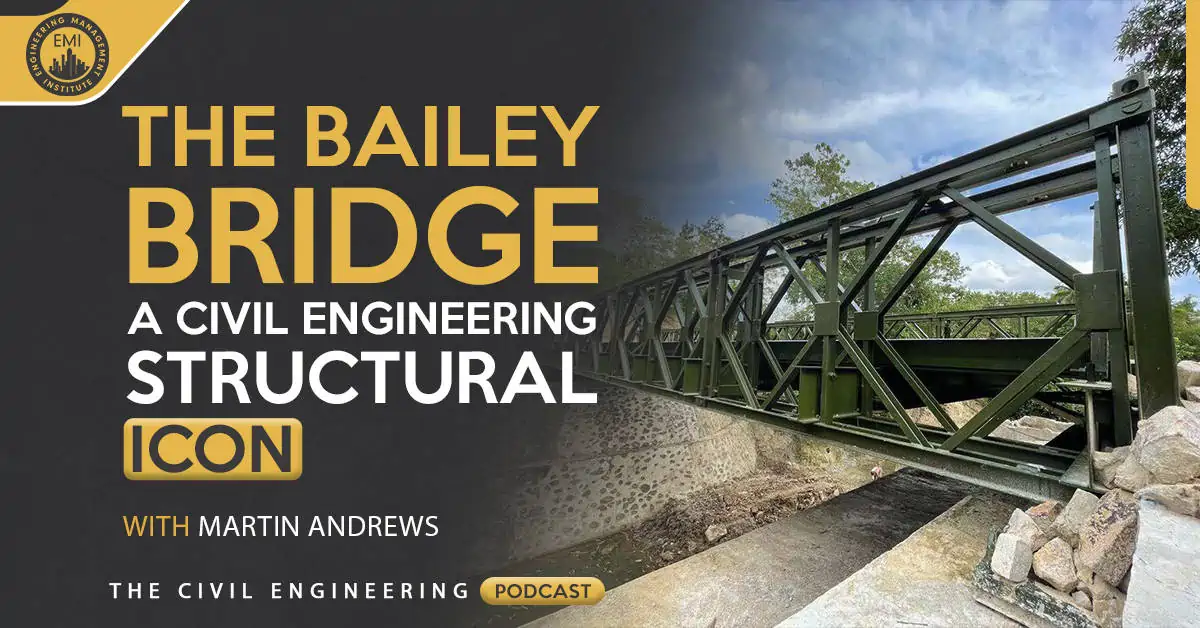Podcast: Play in new window | Download | Embed
In episode 060 of The Civil Engineering Podcast, I talk with Martin Andrews, Military Sales Manager for Mabey Bridge Limited about the development of the Mabey Logistic Support Bridge from its origins in the Bailey Bridge.
Here are some of the questions I ask Martin on the Bailey Bridge:
- Can you tell us a little bit about what the Bailey Bridge is and the history of the Bailey Bridge?
- What made the design revolutionary at the time?
- What makes this bridge so useful in comparison to say, a more traditional site-specific bridge design?
- We’re decades on from World War II, so what types of design improvements have been made to the original design?
- Do you rely on an in-house civil/structural engineer design capability to support clients, or do clients use their own civil engineers to design bridge applications?
- What is the design service life for this type of bridge, and what is the longest in-service bridge that you’re aware of?
- What maintenance is required on one of these types of bridges?
- Say I’m a civil engineer and I want to source one of these bridges for a job, what do I need to know?
- Can you share a couple of examples of more recent Mabey bridge applications?
Engineering Quotes
Here are some key points discussed in this episode:
- The Bailey bridge is a modular steel panel bridge and it came into existence because the new British tank, at the beginning of the war, had proven too much for the existing military system.
- The design was revolutionary and that was because it was a modular steel bridge comprised of rectangular panels pinned together to make the bridge trusses. The panels were made from readily available rolled steel sections welded together in a now familiar Bailey Pan.
- The bridge was a British system, it was never a bridge that could only scan a fixed gap. It was a system that could span in theory any gap and take any weight of the vehicles around at the time.
- The Bailey bridge was pre-engineered and therefore the design was presented to the user in a table which showed all the engineering that they really had to do, to decide what’s required for the bridge. There were subsequent tables which helped them to work out how many components they needed for each design, and subsequently, they could work out how many trucks they needed or how many times they had to cycle through the trucks to deliver the bridge aside. It came in a comprehension handbook where these details were taken into consideration.
- The Bailey bridge was made under a license for the first 25 years. The license ran out in 1967 and Mr. Mabey had some great ideas for improving the design of the Bridge and made several incremental improvements over the subsequent years.
- The original Bailey had a timber deck and four transoms per bay of bricks. In 1967 Super Bailey was introduced by Mabey and it was a huge improvement in the quality of the steel. Some of the specific evolutionary improvements include a steel deck, stronger transoms, close tolerance bolts for rigidity and strength, stronger, deeper panels, the introduction of high shear panels, improved chords for bending. Joint development with British Army of Ground beams and grillages and an adjustable ramp system.
- The design service life of the bridges is about 60 years, but it does depend hugely on the traffic. At least 100,000 cycles (25 crossings every day for 10 years) is guaranteed of the design load for the decks, but it can go up to 2 million.
- A recommend inspection after one month is required, after that, every three months, or at least once a year depending on the volume of traffic. These inspections are to check that the bolts remain tight. All components are galvanized and the galvanizing should last at least 40 – 60 years.
More details in this episode…
About Martin Andrews:
Martin Andrews is the Military Sales Manager for Mabey Bridge Limited where he works with ministries of defense and military forces from around the world to support their bridging needs. He served in the British Army Royal Engineers, retiring as a Lieutenant Colonel and he has extensive experience in the planning and conduct of national, multinational and NATO operation, as well as in Engineer logistics and equipment management worldwide.
Sources/References:
Military Load Classifications
Mabey Website
Bridging Overview
Arup and Mabey Deliver First Rapid Assembly, Polymer, Modular Bridge
Mabey Compact 200™ Video 1
Mabey Compact 200™ Video 2
This episode is brought to you by PPI, the leader of civil engineering FE or PE exam preparations. Use promo code PREP and enter the raffle here: www.ppi2pass.com/civilprep
This episode is also brought to you by SkiCiv, a new and powerful structural analysis software on the cloud that is changing the way engineers work. To receive your free 14-day trial, sign up here: www.skyciv.com/coach
Books mentioned in this episode:
Please leave your comments or questions in the section below on the Bailey Bridge.
To your success,
Christian Knutson, PE, PMP
Engineering Management Institute








